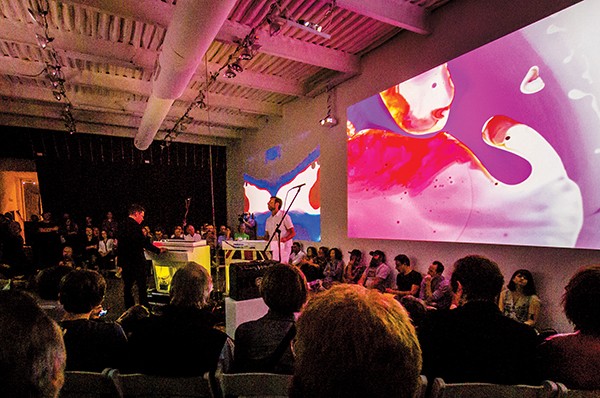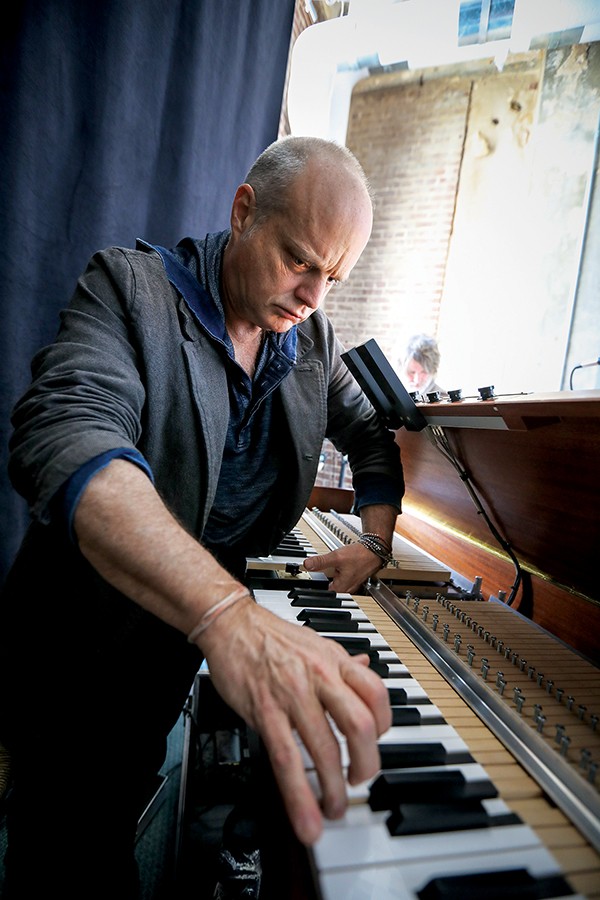“When I’m playing a real Mellotron, it’s like I’m playing ghosts,” says Pat Sansone, multi-instrumentalist for Wilco, who’s in town for a series of concerts this week. It’s not a comment you would hear about many instruments, but the Mellotron is unique. Its immediate precursor was the Chamberlin, in which strips of audio tape triggered by a keyboard could mimic various orchestral instruments. When a Chamberlin employee absconded to England with two of the machines in 1962, he created his own consumer-oriented model, and the Mellotron was born. The new instrument, using lower fidelity recordings, tended to color the sound of the instruments with its own warble and woof. Before long, it was appearing on records by the Beatles, the Kinks, and others.
It’s that slightly corrupted sound that makes the Mellotron a sought-after keyboard to this day, and it’s what brought Sansone to Memphis to collaborate with three other musicians in shows using multiple Mellotrons simultaneously.
 Jamie Harmon
Jamie Harmon
Pat Sansone contemplates the next note
“The way the old Mellotron tapes were recorded, with the amount of degeneration that happened before they got to the machines themselves, they’re just instantly evocative,” Sansone explains. “There’s already a sense of passed time built into those sounds. It’s like a faded photograph, where you see somebody in the corner. There’s a humanity creeping around inside those sounds.”
It was that mechanically tweaked humanity that appealed to Winston Eggleston (the son of photographer William Eggleston) when he plunged into the world of Mellotron schematics to make his own. Eggleston, ended up building and collecting a few of them, leading his friend, musician Robby Grant (Big Ass Truck, >manualcontrol<, Mouserocket), to ask, “What now?”
As Grant describes the process, “I reached out to cellist Jonathan Kirkscey and we created new music using only Mellotrons. Neither of us was a keyboard player.” But technical virtuosity was not the point. All of Memphis was abuzz with the results: two sold-out shows in 2016, dubbed Duets for Mellotron. The show was enhanced by projections designed by Winston Eggleston and John Markham.
 Jason Schepman
Jason Schepman
with Jonathan Kirskcey and Robby Grant .
Following the success of the duets, “a person from Crosstown mentioned an interdisciplinary NEA grant — that we eventually were awarded. What we did was make it a lot bigger,” Grant says. “We’re gonna put on multiple shows. The first piece will be Robert Patterson. He’s a composer with the Memphis Symphony Orchestra, and he’s gonna be contrasting the Mellotron with real flutes and real cellos in his chamber music pieces. Then, we have the New Ballet Ensemble (NBE) working with Ross Rice,” the erstwhile Memphian, producer and keyboard wizard.
The capstone of this year’s project, known as Mellotron Variations, will be a performance (again featuring the projections of Eggleston and Markham) by a quartet of Mellotron players including Grant, Kirkscey, Sansone, and jazz/funk keyboardist John Medeski, of the trio Medeski, Martin & Wood. Sansone says he’s excited to be playing with Medeski. “He is such a deep musician, and bringing a whole new level of musicianship to it. He’s a fearless player.”
 Jamie Harmon
Jamie Harmon
John Medeski
For Medeski, fearlessness is key. “How do you push the limits of an instrument? That’s what Hendrix and so many great musicians did. This instrument can be both a sampler and, by messing with the speed of the wheel inside it, you can be a DJ. It’s really an expressive thing.”
“I heard a recording of Captain Beefheart doing this incredible Mellotron solo,” Medeski goes on, “that really blew it open for me and made me realize it’s so much more than just fake strings with a weird sound. That inspired me in terms of not being afraid. It’s an expressive instrument unto itself. Imitating something for the sake of imitating it is stupid. Why not just get violin players? But the Mellotron has a total sound of its own.”
Grant and Kirkscey were committed to pushing the instrument’s boundaries as well, in part by recording new sounds, previously unheard in vintage Mellotron iterations, including eerie cello and flute harmonics, backwards guitar, and children reciting spoken word pieces. Together, the four have created semi-improvised works that they’ll premier this week. Medeski notes, “Improvisation is composition; it’s just immediate. You make a sound, and what note you choose next, where you put it in time, is like composing, except you’re doing it really fast. And the other guys are all that kind of musician. It’s such a cool project. I’m just excited to be part of it, and I’m honored.”
For an exhaustive listing of albums and songs featuring the Mellotron, see Planet Mellotron.

 Jamie Harmon
Jamie Harmon  Jamie Harmon
Jamie Harmon  Jason Schepman
Jason Schepman  Jamie Harmon
Jamie Harmon